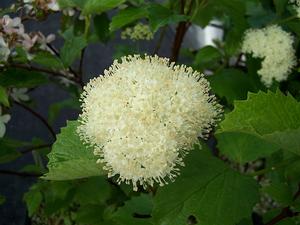View All Plants :: View All DECIDUOUS SHRUBS :: View All SHRUBS
Viburnum dentatum 'Moonglow'
Southern Arrowwood
Plant Type:
DECIDUOUS SHRUBSViburnum dentatum 'Moonglow' (also found as 'Moonglo') - A handsome, rounded habit on a smaller Arrowwood Viburnum, aka Southern Arrowwood. White flowers in May and possibly to late June are atypically domed - not flattened, each a full moon. It's lovely. Profuse extended stamens turn reddish to red-brown seasoning the white as they age. Fruits are larger than normal maturing dark blue in late August to early September. Leaves are very glossy and are broader and less serrated than found typically. The extraordinary autumn color emerges checkered (Gary Ladman describes it as "Indian corn" - nicely put!) in green, gold and red-maroon tones subtending the dark blueberry-colored fruit clusters making for a harvest cornucopia. All the Viburnum are beneficial to birds, bees and butterflies with a host of other insects joining in on the pollination efforts. Plant in fertile, well-drained soils with a part to full sun exposure. Drought tolerance. Deer resistance. The only characteristic missing is fragrance... people - we can't have everything! This is a selection of garden origin. The species occurs from Maine to Iowa, south to Texas, east to the Atlantic though appears to be curiously absent from Vermont and New Hampshire... it this true? The common name, Arrowwood, is derived from the fact that this species was used by some Amerindian tribes for arrow shafts as the stems tend to be perfectly straight. It is the serrations in this species generally that inspires the botanical Latin name "dentatum", the "dent" referring to teeth. Established potted shrub from cutting.
On 2.20.2022 we received correspondence from the introducer of 'Moonglo', Howard (Bill) Barnes: "I found Moonglo in 1990 while working at Moon Nursery in Pennsylvania. It was part of a large block of plants Viburnum dentatum and was distinctive in being more compact and heavier flowering. Cuttings were taken, and distributed , there was a write up about it in the American Nurseryman magazine back then."
Characteristics and Attributes for Viburnum dentatum 'Moonglow'
Season of Interest (Flowering)
- Spring
Season of Interest (Foliage)
- Spring / Summer / Autumn
Autumn Interest
- Fruit / Berries / Seed Heads
- Autumn Leaf Color
Nature Attraction
- Honey Bees & Native Bees
- Deer Resistant
- Butterflies
- Songbirds
Light
- Morning Sun / Afternoon Shade
- Shade Tolerant
Attributes
- Natural Garden
- Specimen
- Wildlife Garden
- Shrub Border
- Hedgerow
Growth Rate in the Garden
- Moderately Fast
Soil
- Draining
- Fertile
Origins
- Garden Origin
Genus Overview: Viburnum
Common Name: Viburnum
Viburnum. This genus is full of fantastic, multi-season garden worthy shrubs. Garden heroes. Spring flowers, often large and showy, many with heady sweet fragrance are arranged in cymes. Some smell of musk (Viburnum dilatatum) while others produce no fragrance at all. Flowers are followed with berries. If late season and autumn berries are desired then planting two of a species will ensure fruit set; for instance, Viburnum dilatatum 'Erie' and V. dilatatum 'Michael Dodge' will pollinate each other and produce fruit. Viburnum cassinoides is closely allied with V. nudum; but if the flowering times do not overlap then there will be no fruit. However, if you plant V. nudum 'Winterthur' in proximity with V. nudum var. angustifolium, 'Longwood', 'Moonshine' or 'Pink Beauty' berries will abound. Another interesting example is V. lantana which crosses with V. burejaeticum and vice versa. Any V. plicatum f. tomentosum selection such as 'Shasta' or 'Shoshoni' will pollinate with all other V. plicatum f. tomentosum selections like 'Copper Ridges or 'Pink Beauty'. But if you were to plant two 'Shasta' side by side with no other V. plicatum f. tomentosum in near proximity then your effort will be fruitless. As with almost all in the universe of plants there are exceptions. There is one viburnum which appears to be self-fruitful, Viburnum setigerum the Tea Viburnum. Another interesting exception to the rule is Viburnum nudum 'Pink Beauty' which is also self-fruitful - a departure from its siblings. And on the other spectrum are two I can think of off-hand that are barren, Viburnum plicatum 'Roseum' and Viburnum plicatum 'Kern's Pink'. Oftentimes, the dwarf viburnums reamin in a juvenile state and do not produce fruit. All Viburnum of any size that do produce fruit are magnificent in the late season garden. And they feed all manner of birds. Larger, denser shrubs provide cover and nesting opportunities. Nearly all Viburnum have terrific autumn foliage colors, too. Viburnums are members of Caprifoliaceae. All prefer part to full sun and fertile soils. All are cutting grown. Many thanks to Gary Ladman of Classic Viburnums who generously set us straight regarding some of the details we had originally incorrectly lauded... ya can't know everything!


